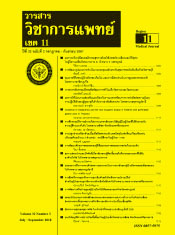Screening for suspected developmental delay among infants and toddlers
Keywords:
suspected developmental delay, infants, toddlersAbstract
Background: Developmental delay problem directly affected children and their family regarding school achievement, emotion and behavior. Prevalence of delay in different domains of developmental skills was uncertain, depending on age, population and area of study. The information was very important for early intervention and developmental improvement.
Objective: To study the prevalence of suspected developmental delay among infants and toddlers
Method: A cross-sectional study was conducted among children aged 9 months, 18 months and 30 months who visited at well-child clinic in Patthalung hospital from 1 October 2016 to 30 June 2017. Children were assessed on five domains of their developmental skills consisting of gross motor, fine motor, receptive language, expressive language and personal and social skills by using Developmental Surveillance and Promotion Manual (DSPM). Children who could not pass one or more domains were diagnosed as suspected developmental delay. R program and descriptive statistic were used for the prevalence and Chi-square was used to compare the association between groups. P-value less than 0.05 were a statistical significance.
Results: One hundred and sixty three children were recruited and 60.1% of children were toddlers. The prevalence of suspected developmental delay was 39.3% and the majority was found in male children. The prevalence of developmental delay in toddlers was statistical significantly larger than the prevalence in infants (P-value=0.002, RR=1.99; 95%CI=1.24-3.19). For 5 domains of the developmental skills, the most two important problems of infants were fine motor and receptive language skills (13.8%). The prevalence of fine motor and expressive language delay in toddlers aged 18 months were 30.9% and 18.2%. For toddlers aged 30 months, fine motor delay was also the most frequently found (44.2%), and the problem of receptive language and personal social skill reached to 39.5% and 32.6% respectively.
Conclusion: Prevalence of suspected developmental delay among infants and toddlers was high. That was an important health problem in this area. Fine motor and language delay were the most important problems among infants and toddlers. Thus, early and appropriate intervention should be given for the good improvement.
References
Boyle C, Decoufle A, Yeargin-Allsopp M. Prevalence and health impact of developmental disabilities in US children. Pediatrics 1994; 93 : 399–403.
Palfrey JS, Singer JD, Walker DK, Butler JA. Early identification of children’s special needs: a study in five metropolitan comm unities. J Pediatr 1987; 111:651–9.
American Academy of Pediatrics. Identifying infants and young children with developmental disorders in the medical home: an algorithm for developmental surveillance and screening. Pediatrics 2006; 118: 405–20.
Valla L, Wentzel-Larsen T, Hofoss D, Slinning K. Prevalence of suspected developmental delays in early infancy: results from a regional population-based longitudinal
study. BMC Pediatr 2015; 15: 215-22.
Sachdeva S, Amir A, Alam S, Khan Z, Khalique N, Ansari MA. Global devel- opmental delay and its determinants among urban infants and toddlers: a cross sectional study. Indian J Pediatr 2010; 77: 975–80.
กรมสุขภาพจิต. สถานบันพัฒนาการเด็กราชนครินทร์. การศึกษาเปรียบเทียบความไวและความจำเพาะของ DSPM, Final report 18 มีนาคม 2558. นนทบุรี: กรม; 2558. เข้าถึงได้จาก http://www.thaichild-development.com. (สืบค้นเมื่อ 18 มีนาคม 2558)
Chunsuwan I, Hansakunachai T, Porn- samrit S. Parent evaluation of develop- mental status (PEDS) in screening: the Thai experience. Pediatrics International
2016; 58:1277–83.
World Health Organization. Develop- mental difficulties in early childhood: prevention, early identification, assess- ment and intervention in low- and middle income
countries: a review. Turkey: Turkey Country Office and CEECIS Regional Office. WHO 2012.
Rosenberg SA, Zhang D, Robinson CC. Prevalence of developmental delays and participation in early intervention services for young children. Pediatrics
2008; 121: e1503–9.
Kuo HT, Muo CH, Chang YT, Lin CK. Change in prevalence status for children with developmental delay in Taiwan: a nationwide population-based retro-
spective study. Neuropsychiatr Dis Treat 2015; 11: 1541–47.
Hamilton S. Screening for develop- mental delay: reliable, easy-to-use tools win-win solutions for children at risk and busy practitioners. J Fam Pract 2006; 55: 415-22.
สมัย ศิริทองถาวร. การพัฒนาคู่มือเฝ้าระวังและส่งเสริมพัฒนาการเด็กปฐมวัย The development of developmental surveillance and promotion manual; DSPM. วารสารสมาคมจิตแพทย์แห่งประเทศไทย 2561; 63: 3-12.
Wei QW, Zhang JX, Scherpbier RW, Zhao CX, Luo SS, Wang XL, et al. High prevalence of developmental delay among children under three years of age
in poverty-stricken areas of China. Public Health 2015; 129: 1610-7.
Jimoha AO, Anyiamb JO, Yakub AM. Relationship between child development and nutritional status of under-five Nigerian children. South Afr J Clin Nutr
2018; 31: 50–4.
Cools W, De Martelaer K, Samaey C, Andries C. Fundamental movement skill performance of preschool children in relation to family context. J Sports Sci 2011; 29: 649–60.
Piek JP, Dawson L, Smith LM, Gasson N. The role of early fine and gross motor development on later motor and cognitive ability. Hum Mov Sci 2008; 27: 668–81.






